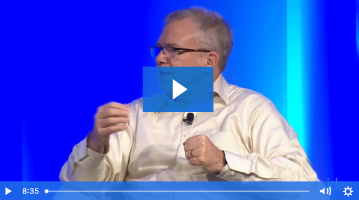Use Multi-Digital Technologies to Future Proof Your Company
By John Yuva, Senior Editor, SAPinsider
According to one market research company, it’s predicted that by 2025 there will be 55.7 billion connected devices worldwide, with 75% connected to an Internet of Things (IoT) platform. How much data does that equal? The company estimates that within that timeframe, 73.1 zettabytes of data will be generated from IoT devices, with a significant portion deriving from industrial IoT applications. This poses both an opportunity and a challenge to companies as they pursue integrations of IoT, artificial intelligence (AI), and machine learning (ML) digital technologies in their enterprise.
SAPinsider recently sat down with Alan Clarke, SAP Alliance Director for EMEA North for SUSE, and Gerren Mayne, SAP Practice Director for Fujitsu in the UK, to discuss the impact of AI, ML, and IoT on the evolving enterprise and how these digital technologies are enabling a future-proof ecosystem for companies.
Explore related questions
Digital Technologies and the Responsive Supply Chain
Mayne observes more clients are now migrating to SAP S/4HANA, creating a much more serious discussion about digital transformation as part of the upgrade process. However, integrating technologies like AI, ML, and IoT alongside complementary solutions to bridge those offerings throughout the enterprise is no small feat. Prior to the pandemic, there was an awareness that IoT and digital technologies represented bleeding-edge technologies (on the technological forefront and untested). What accelerated during and now post-COVID-19 is the need for companies to understand quickly what is occurring in their manufacturing processes and supply chain, Mayne says. How can they detect changes in real time and respond effectively?
One answer is the use of sensors in production equipment. Manufacturers want real-time transparency into potential quality issues on the production line, Mayne says. Consider a manufacturer of aluminum. It’s extremely difficult to detect aluminum imperfections with the human eye. However, using AI sensors, hairline fractures and other defects are exposed before that aluminum batch is applied to a product, leading to a potential recall later.
Digital technology is playing a greater role with connecting manufacturers to their downstream suppliers and upstream customers, Mayne says. Whether it’s downstream or upstream, companies need to ask how supply chain decision-making can affect them.
“The importance of sustainability and ethical sourcing continues to grow, for example, to the point where IoT can provide consumers with sourcing details about the products they’re purchasing,” Mayne says. “Those insights impact brand reputation and customer loyalty.”
Where do companies begin their journey to leverage digital technologies?
Reflecting on the Past, Planning for the Future
Companies wanting to upgrade solely to SAP S/4HANA (with no plans to integrate digital technologies) realized that despite the significant cost investment, they only experienced a bump in speed after implementation. This presented a challenge when making the business case for such a significant upgrade, says Mayne.
After some debate, it became clear that digital technologies were the value proposition alongside an SAP S/4HANA upgrade. But how do companies process all the production and supply chain data flowing through their SAP platforms from digital technologies?
Mayne says companies are taking a backward reflection and examining what they’ve done over the last five years, what they’ve done well, and how to do it quicker and more efficiently in the future. This then leads into exploring what the organization wants to be in five, ten, fifteen, or even twenty years. “With that vision, companies can devise the steppingstones to reach that objective — which inevitably involve new digital technologies to get them there,” Mayne says.
With the growing usage of digital technologies, how are companies engaging these solutions for a more intelligence enterprise?
Agility and Scalability for an Intelligent Enterprise
Two common themes always emerge, says Clarke, when SAP customers discuss their transformation projects — agility and scalability. Both are critical to achieving the intelligent enterprise and the supporting infrastructure, but also to reacting quickly to AI and IoT outputs.
“IoT needs AI and vice versa. With IoT, you’re receiving all the data, while the AI unlocks the real-time responsiveness,” Clarke explains. “Unless you’ve got the supporting infrastructure in place and the SAP intelligent enterprise where it needs to be, the business cannot react quickly.”
Mayne says the most critical customer challenge is identifying a strategy. Customers are trying to determine what components they need and in what sequence they should be implemented. They are wondering, what does the roadmap for digital technologies look like? Should I adopt these technologies prior to upgrading SAP? Do I implement them at the same time or upgrade to SAP first?
Clarke adds that every customer is hungry for information because it represents the biggest SAP sea change in a generation. Decisions around digital technologies and the intelligent enterprise can impact the potential success and maximum profitability of the company. “There is enormous pressure from stakeholders to get it right,” Clarke says. “But it’s important for them to know that they’re not alone on this journey.”
Integrate Technology Layers
For more than 20 years, Clarke says SUSE and Fujitsu have partnered on technology innovation to cultivate supporting infrastructure for customers and their mission-critical workloads. SAP serves as the most prevalent platform in their partnership, with SUSE utilizing its open-source technologies alongside Fujitsu’s co-created open solutions that simplify complex IT environments.
“Fujitsu works with SUSE to ensure that those technologies and systems are brought together coherently and in an open-source, open framework manner that adds value to our clients,” he says.
Companies like SUSE and Fujitsu understand the difficulties companies face. A complete end-to-end service can provide the ideal support in choosing the appropriate platform for a customer’s SAP environment, Mayne says. Customers often require management and maintenance of their SAP applications, especially as they upgrade from SAP ERP Central Component to SAP S/4HANA.
“We help clients with the integration of those estates with their wider application estate. We’ll run and maintain their SAP estates and help make sense of the digital technology landscape and put it into context,” Mayne explains. “We’re that integration partner that helps them make sense of the spaghetti that digitally transforms where they are today to where they want to be in the future.”
Clarke adds that SUSE underpins Fujitsu’s solutions with its own technology. While SAP’s Data Intelligence runs based on a containerized management platform, SUSE Rancher is certified to perform underneath SAP’s application.
“We often refer to SUSE as under-the-bonnet technology — the oil in the engine that users are unaware of,” Clarke says. “It’s where our supporting open-source technology underpins the Fujitsu platform. And from there, Fujitsu can comprehensively service their customers with end-to-end service.”
What does the future hold for enterprises and digital technology integration?
Only the Beginning
Nearly everyone in their personal and business lives are touched by digital technologies. The acceleration of AI, ML, and IoT is occurring at a phenomenal speed, says Clarke. Companies like SUSE and Fujitsu are already working to support the advances digital technologies will bring in the near future. “Any company that doesn’t have AI, ML, and IoT firmly on their roadmap are likely to fall short,” Clarke says.
What Does This Mean for SAPinsiders
- More data means a greater emphasis on security. With more data going into the cloud, companies must balance data privacy, confidentiality, and integrity to ensure they are aligned with industry regulations. Also, the importance of data security against increasing cyberattacks cannot be overstated.
- The future state may not be what the business is today. Understanding what data leads to competitiveness and transformation will be one of the biggest future challenges. Mayne says, “You’ll have insight into everything you can think of, but what will ultimately enable organizational transformation and competitive advantage?” The answer may require shifting the product or service focus of the enterprise.
- Expect digital technologies to become more pervasive. According to Mayne, what is going to drive further adoption of digital technologies and ease integration is 5G and edge networks. “You’ll see an explosion of digital technologies with 5G-enablement, which will drive down technology costs and deployment expenses,” says Mayne. “It will all become self-building because as you get more devices, you get more data. And as you get more data, the more there is to synthesize.”







